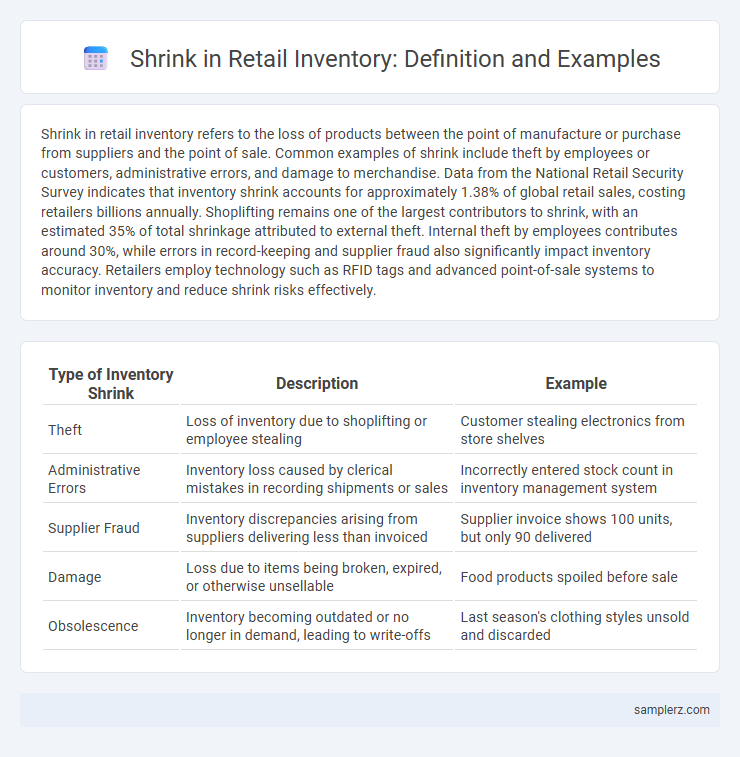Shrink in retail inventory refers to the loss of products between the point of manufacture or purchase from suppliers and the point of sale. Common examples of shrink include theft by employees or customers, administrative errors, and damage to merchandise. Data from the National Retail Security Survey indicates that inventory shrink accounts for approximately 1.38% of global retail sales, costing retailers billions annually. Shoplifting remains one of the largest contributors to shrink, with an estimated 35% of total shrinkage attributed to external theft. Internal theft by employees contributes around 30%, while errors in record-keeping and supplier fraud also significantly impact inventory accuracy. Retailers employ technology such as RFID tags and advanced point-of-sale systems to monitor inventory and reduce shrink risks effectively.
Table of Comparison
| Type of Inventory Shrink | Description | Example |
|---|---|---|
| Theft | Loss of inventory due to shoplifting or employee stealing | Customer stealing electronics from store shelves |
| Administrative Errors | Inventory loss caused by clerical mistakes in recording shipments or sales | Incorrectly entered stock count in inventory management system |
| Supplier Fraud | Inventory discrepancies arising from suppliers delivering less than invoiced | Supplier invoice shows 100 units, but only 90 delivered |
| Damage | Loss due to items being broken, expired, or otherwise unsellable | Food products spoiled before sale |
| Obsolescence | Inventory becoming outdated or no longer in demand, leading to write-offs | Last season's clothing styles unsold and discarded |
Common Causes of Inventory Shrink in Retail
Inventory shrink in retail commonly arises from employee theft, shoplifting, and administrative errors such as incorrect price tagging or misplacement of stock. Supplier fraud and damaged goods also contribute significantly to inventory discrepancies. Effective inventory management systems and regular audits are crucial strategies to minimize these losses.
Real-World Examples of Shrinkage Incidents
Retail inventory shrinkage often results from theft, such as the 2019 incident at a major U.S. Walmart store where shoplifters stole over $15,000 worth of electronics in a single event. Another example includes employee theft at a Target location in California, which led to a loss of more than $50,000 in merchandise over several months. These real-world shrinkage incidents highlight the critical need for advanced loss prevention strategies in retail environments.
Shoplifting: The Most Widespread Shrink Example
Shoplifting accounts for approximately 36% of retail inventory shrink, making it the most widespread cause of inventory loss. Retailers lose billions annually due to stolen merchandise, affecting profit margins and supply chain efficiency. Implementing advanced loss prevention techniques like electronic article surveillance and employee training can significantly reduce shoplifting incidents.
Employee Theft and Internal Shrinkage Cases
Employee theft constitutes a significant portion of internal shrinkage in retail, with surveys indicating it accounts for approximately 40% of total inventory losses. Common cases involve unauthorized removal of merchandise, manipulation of sales records, and theft of cash or stock during inventory handling. Implementing robust surveillance systems, employee training, and strict inventory controls can effectively reduce these internal shrinkage incidents.
Administrative Errors Leading to Inventory Shrink
Administrative errors contribute significantly to inventory shrink in retail, with mislabeling and incorrect data entry causing stock discrepancies. Improper recording of received goods or misplaced stock during audits results in inaccurate inventory counts, impacting replenishment decisions. These errors can lead to financial losses estimated to account for up to 15% of overall shrinkage in retail stores.
Supplier Fraud: Hidden Causes of Shrink
Supplier fraud contributes significantly to inventory shrink in retail through practices such as short shipments, counterfeit products, and inflated invoicing. These hidden causes lead to discrepancies between reported stock levels and actual inventory, impacting profit margins and operational efficiency. Detecting supplier fraud requires rigorous auditing, advanced analytics, and strong supplier relationship management to minimize losses.
Damage and Spoilage as Factors in Inventory Loss
Damage and spoilage significantly contribute to inventory shrinkage in retail by rendering products unsellable or reducing their market value. Perishable goods such as fresh produce, dairy, and meat are particularly vulnerable to spoilage due to improper storage or handling. Damage from mishandling during stocking, transportation, or customer interaction further exacerbates inventory loss, impacting overall profitability and supply chain efficiency.
Return Fraud: An Overlooked Shrink Example
Return fraud significantly contributes to inventory shrinkage in retail by exploiting return policies to receive unwarranted refunds or merchandise. This type of fraud includes practices like returning stolen goods, using counterfeit receipts, or repeatedly returning used items. Retailers lose billions annually due to return fraud, highlighting the need for robust return verification systems and employee training to detect and prevent such shrinkage.
Technological Solutions to Identify Shrinkage
Retailers employ advanced technological solutions such as RFID tagging and AI-powered video analytics to accurately track inventory levels and identify shrinkage in real-time. These systems enable the detection of theft, misplacement, or administrative errors by monitoring movement patterns and alerting staff to irregularities promptly. Integration of IoT sensors further enhances inventory visibility, allowing seamless stock reconciliation and minimizing loss.
Strategies for Preventing Shrink in Retail Inventory
Implementing advanced inventory tracking systems such as RFID and barcode scanning significantly reduces shrink by enhancing accuracy and real-time visibility. Training employees on theft prevention and establishing strict loss prevention policies create a culture of accountability that deters employee pilferage and shoplifting. Regular inventory audits combined with video surveillance and secure storage solutions effectively identify discrepancies early, minimizing financial losses due to shrinkage.

example of shrink in inventory Infographic
 samplerz.com
samplerz.com